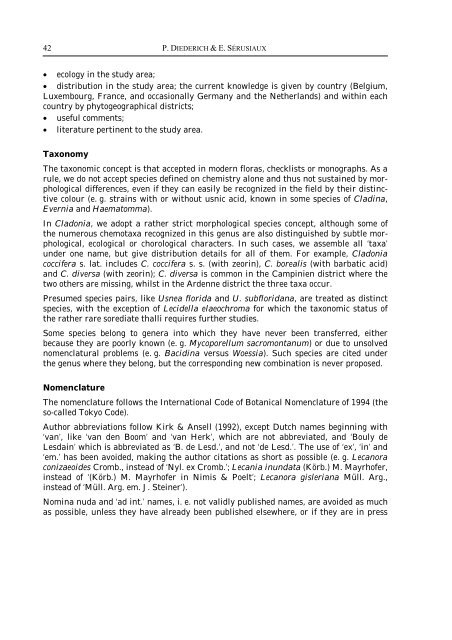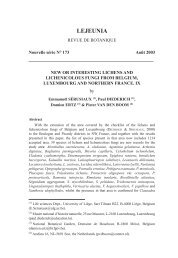The Lichens and Lichenicolous Fungi of Belgium and Luxembourg ...
The Lichens and Lichenicolous Fungi of Belgium and Luxembourg ...
The Lichens and Lichenicolous Fungi of Belgium and Luxembourg ...
You also want an ePaper? Increase the reach of your titles
YUMPU automatically turns print PDFs into web optimized ePapers that Google loves.
42 P. DIEDERICH & E. SÉRUSIAUX<br />
• ecology in the study area;<br />
• distribution in the study area; the current knowledge is given by country (<strong>Belgium</strong>,<br />
<strong>Luxembourg</strong>, France, <strong>and</strong> occasionally Germany <strong>and</strong> the Netherl<strong>and</strong>s) <strong>and</strong> within each<br />
country by phytogeographical districts;<br />
• useful comments;<br />
• literature pertinent to the study area.<br />
Taxonomy<br />
<strong>The</strong> taxonomic concept is that accepted in modern floras, checklists or monographs. As a<br />
rule, we do not accept species defined on chemistry alone <strong>and</strong> thus not sustained by morphological<br />
differences, even if they can easily be recognized in the field by their distinctive<br />
colour (e. g. strains with or without usnic acid, known in some species <strong>of</strong> Cladina,<br />
Evernia <strong>and</strong> Haematomma).<br />
In Cladonia, we adopt a rather strict morphological species concept, although some <strong>of</strong><br />
the numerous chemotaxa recognized in this genus are also distinguished by subtle morphological,<br />
ecological or chorological characters. In such cases, we assemble all ‘taxa’<br />
under one name, but give distribution details for all <strong>of</strong> them. For example, Cladonia<br />
coccifera s. lat. includes C. coccifera s. s. (with zeorin), C. borealis (with barbatic acid)<br />
<strong>and</strong> C. diversa (with zeorin); C. diversa is common in the Campinien district where the<br />
two others are missing, whilst in the Ardenne district the three taxa occur.<br />
Presumed species pairs, like Usnea florida <strong>and</strong> U. subfloridana, are treated as distinct<br />
species, with the exception <strong>of</strong> Lecidella elaeochroma for which the taxonomic status <strong>of</strong><br />
the rather rare sorediate thalli requires further studies.<br />
Some species belong to genera into which they have never been transferred, either<br />
because they are poorly known (e. g. Mycoporellum sacromontanum) or due to unsolved<br />
nomenclatural problems (e. g. Bacidina versus Woessia). Such species are cited under<br />
the genus where they belong, but the corresponding new combination is never proposed.<br />
Nomenclature<br />
<strong>The</strong> nomenclature follows the International Code <strong>of</strong> Botanical Nomenclature <strong>of</strong> 1994 (the<br />
so-called Tokyo Code).<br />
Author abbreviations follow Kirk & Ansell (1992), except Dutch names beginning with<br />
‘van’, like ‘van den Boom’ <strong>and</strong> ‘van Herk’, which are not abbreviated, <strong>and</strong> ‘Bouly de<br />
Lesdain’ which is abbreviated as ‘B. de Lesd.’, <strong>and</strong> not ‘de Lesd.’. <strong>The</strong> use <strong>of</strong> ‘ex’, ‘in’ <strong>and</strong><br />
‘em.’ has been avoided, making the author citations as short as possible (e. g. Lecanora<br />
conizaeoides Cromb., instead <strong>of</strong> ‘Nyl. ex Cromb.’; Lecania inundata (Körb.) M. Mayrh<strong>of</strong>er,<br />
instead <strong>of</strong> ‘(Körb.) M. Mayrh<strong>of</strong>er in Nimis & Poelt’; Lecanora gisleriana Müll. Arg.,<br />
instead <strong>of</strong> ‘Müll. Arg. em. J. Steiner’).<br />
Nomina nuda <strong>and</strong> ‘ad int.’ names, i. e. not validly published names, are avoided as much<br />
as possible, unless they have already been published elsewhere, or if they are in press





